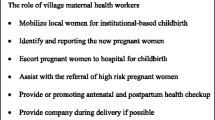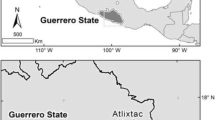Abstract
Policies about skilled birth attendants (SBA) need to account for cultural acceptability of care rendered by SBAs. Few studies have assessed these policies from the perspective of SBAs. I identify challenges and analyze the experiences of SBAs implementing a culturally appropriate birth care policy in Peru. I collected data during 15 months of ethnographic research: conducting semi-structured interviews and informal conversations with 5 SBAs in 2 villages and with health officials. I compared interview results with my observations of consultations and of labor and delivery. Weak institutional support, lack of training, negative perceptions of the policy inhibited implementation, as did detrimental effects on future personal and professional opportunities. SBAs in Peru face many challenges when trying to establish intercultural birth care. My recommendations include provision of focused training, promoting a more diverse workforce, and increasing community engagement.
Similar content being viewed by others
References
Liljestrand, J. (2000) Strategies to reduce maternal mortality worldwide. Current Opinion in Obstetrics & Gynecology 12(6): 513–517.
Sibley, L.M., Sipe, T.A., Brown, C.M., Diallo, M.M., McNatt, K. and Habarta, N. (2007) Traditional birth attendant training for improving health behaviours and pregnancy outcomes (Review). Cochrane Database of Systematic Reviews 3: CD005460.
WHO. (2004) Making Pregnancy Safer: The Critical Role of the Skilled Attendant: A Joint Statement by WHO, ICM and FIGO. Geneva, Switzerland: World Health Organization.
Campbell, O. and Graham, W. (2006) Strategies for reducing maternal mortality: Getting on with what works. The Lancet 368(9543): 1284–1299.
Adegoke, A.A. and van den Broek, N. (2009) Skilled birth attendance-lessons learnt. BJOG: An International Journal of Obstetrics & Gynaecology 116(1): 33–40.
UNFPA, ICM, WHO. (2014) The State of the World’s Midwifery 2014: A Universal Pathway. New York: UNFPA.
Bohren, M.A., Hunter, E.C., Munthe-Kaas, H.M., Souza, J.P., Vogel, J.P. and Gulmezoglu, A. (2014) Facilitators and barriers to facility-based delivery in low-and middle-income countries: A qualitative evidence synthesis. Reproductive Health 11(1): 71.
Nakua, E.K., Sevugu, J.T., Dzomeku, V.M., Otupiri, E., Lipkovich, H.R. and Owusu-Dabo, E. (2015) Home birth without skilled attendants despite millennium villages project intervention in Ghana: Insight from a survey of women’s perceptions of skilled obstetric care. BMC Pregnancy and Childbirth 15: 243, doi: 10.1186/s12884-015-0674-1
Silal, S.P., Penn-Kekana, L., Harris, B., Birch, S. and McIntyre, D. (2012) Exploring inequalities in access to and use of maternal health services in South Africa. BMC Health Services Research 12(1): 120.
Sarfraz, M. and Hamid, S. (2014) Challenges in delivery of skilled maternal care – experiences of community midwives in Pakistan. BMC Pregnancy and Childbirth 14: 59. doi:10.1186/1471-2393-14-59.
Mannah, M.T., Warren, C., Kuria, S. and Adegoke, A.A. (2014) Opportunities and challenges in implementing community based skilled birth attendance strategy in Kenya. BMC Pregnancy and Childbirth 14: 279. doi:10.1186/1471-2393-14-279 .
Vieira, C., Portela, A., Miller, T., Coast, E., Leone, T. and Marston, C. (2012) Increasing the use of skilled health personnel where traditional birth attendants were providers of childbirth care: A systematic review. PLoS One 7(10): e47946.
Mumtaz, Z., O’Brien, B., Bhatti, A. and Jhangri, G.S. (2012) Are community midwives addressing the inequities in access to skilled birth attendance in Punjab, Pakistan? Gender, class and social exclusion. BMC Health Services Research 12: 326. doi:10.1186/1472-6963-12-326.
Byrne, A. and Morgan, A. (2011) How the integration of traditional birth attendants with formal health systems can increase skilled birth attendance. International Journal of Gynaecology and Obstetetrics 115(2): 127–134.
Stanton, C. (2008) Steps towards achieving skilled attendance at birth. Bulletin of the World Health Organization 86(4): 242–243.
Morgan, A., Jimenez Soto, E., Bhandari, G. and Kermode, M. (2014) Provider perspectives on the enabling environment required for skilled birth attendance: A qualitative study in western Nepal. Tropical Medicine & International Health 19(12): 1457–1465.
Sychareun, V. et al (2013) Provider perspectives on constraints in providing maternal, neonatal and child health services in the Lao People’s democratic republic: A qualitative study. BMC Pregnancy and Childbirth 13(1): 243.
Shore, C., Wright, S. and Peró, D. (2011) Policy Worlds: Anthropology and Analysis of Contemporary Power. Oxford: Berghahn Books.
INEI. (2011) Peru: Demographic and Health Survey 2010. Lima, Peru: INEI.
INEI. (2015) Peru: Demographic and Health Survey 2014. Lima, Peru: INEI.
Yamin, A.E. (2008) Steps to enhance Peru's progress on maternal mortality. The Lancet 372(9636): 370.
del Carpio Ancaya, L. (2013) Situación de la mortalidad materna en el Perú, 2000–2012. Revista Peruana de Medicina Experimental y Salud Publica 30(3): 461–464.
Camacho, A., Castro, M. and Kaufman, R. (2006) Cultural aspects related to the health of Andean women in Latin America: A key issue for progress toward the attainment of the Millennium Development Goals. International Journal of Gynecology & Obstetrics 94(3): 357–363.
Foster, G.M. (1984) Hippocrates’ Latin American legacy: Humoral Medicine in the New World. Amsterdam: Gordon & Breach Science Pub.
Larme, A.C. and Leatherman, T. (2003) Why sobreparto: Women’s work, health, and reproduction in two districts in southern Peru. In: J. Koss-Chioino, T. Leatherman and C. Greenway (eds.) Medical Pluralism in the Andes. London and New York: Routledge, pp. 191–208.
Burgos Lingan, M.O. (1995) El Ritual del Parto en los Andes. MA thesis, Katholieke University Nijmegen, The Netherlands.
Reyes, E. (2007) En nombre del Estado: servidores publicos en una microrred de salud en la costa rural del Peru. Lima, Peru: IEP.
MINSA. (2005) Technical Regulation for Vertical Delivery Care with Intercultural Adaptation. Lima, Peru: Ministry of Health Peru.
Fraser, B. (2008) Peru makes progress on maternal health. The Lancet 371(9620): 1233–1234.
Nureña, C.R. (2009) Incorporación del enfoque intercultural en el sistema de salud peruano: la atención del parto vertical. Rev Panam Salud Pública 26(4): 368–376.
MINSA. (2009) Plan Estrategico Nacional para la Redccion de la Mortalidad Materna y Perinatal 2009–2015. Lima, Peru: MINSA PERU.
Amnistía Internacional. (2009) Deficiencias Fatales: Las Barreras a la Salud Materna en Perú. Madrid, Spain: Amnistia Internacional.
Bernard, H.R. (2002) Research Methods in Anthropology. Qualitative and Quantitative Approaches, 3rd edn. Walnut Creek, CA: Altamira.
Tavera, M. (2010) Fortalecimiento de servicios rurales de atencion del parto con enfoque intercultural. In: G. Fernandez Juarez (ed.) Salud, Interculturalidad y Derechos. Quito: Abya Yala and UNFPA, pp. 235–238.
Global Health Workforce Alliance. (2013) Mid-level Health Workers for Delivery of Essential Health Services: A Global Systematic Review and Country Experiences., Country Annex 12-Peru Geneva, Switzerland: WHO.
Yanagisawa, S., Oum, S. and Wakai, S. (2006) Determinants of skilled birth attendance in rural Cambodia. Tropical Medicine and International Health 11(2): 238–251.
Dhakal, S., van Teijlingen, E., Raja, E.A. and Dhakal, K.B. (2011) Skilled care at birth among rural women in Nepal: Practice and challenges. Journal of Health Population and Nutrition, August 29(4): 371–378.
Mirkuzie, A.H. (2014) Exploring inequities in skilled care at birth among migrant population in a metropolitan city Addis Ababa, Ethiopia; a qualitative study. International Journal for Equity in Health 13: 110, doi:10.1186/s12939-014-0110-6.
Castro, A., Savage, V. and Kaufman, H. (2015) Assessing equitable care for indigenous and afrodescendant women in Latin America. Revista Panamericana de Salud Pública 38(2): 96–109.
Reyes, E. and Valdivia, N. (2010) La discriminacion en el Peru y el caso de la salud: resultados de un estudio cualitativo sobre la atención a pacientes en una microrred del Valle del Mantaro. Lima, Peru: GRADE.
Valdivia, M. (2011) Etnicidad como determinante de la inequidad en salud materno-infantil en el Perú. In: A. Hernández Bello and C. Rico de Sotelo (eds.) Protección social en salud en América Latina y el Caribe: Investigación y políticas Bogotá. Bogota: Editorial Pontificia Universidad Javeriana, pp. 121–158.
Acknowledgements
This research was funded by a United States National Science Foundation (NSF) Doctoral Dissertation Improvement Grant Number 0918030.
Author information
Authors and Affiliations
Corresponding author
Rights and permissions
About this article
Cite this article
Guerra-Reyes, L. Implementing a culturally appropriate birthing policy: Ethnographic analysis of the experiences of skilled birth attendants in Peru. J Public Health Pol 37, 353–368 (2016). https://doi.org/10.1057/jphp.2016.19
Published:
Issue Date:
DOI: https://doi.org/10.1057/jphp.2016.19




